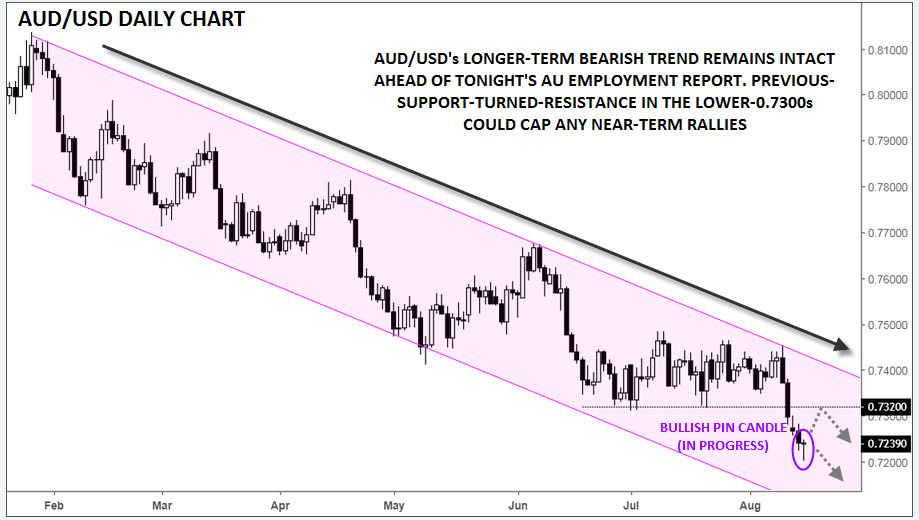The price action so far today is emblematic of a textbook “risk off” day: stocks are falling across the globe, oil is trading off by nearly 3%, bond yields are generally retreating, and the yen is the strongest performing major currency (though we would note that gold bugs still can’t seem to catch a break!).
One other apparent outlier is the Australian dollar, which is traditionally seen as one of the major currencies that is most sensitive to risk appetite. While it’s hardly setting traders’ heat maps ablaze, the Aussie is holding its ground against currencies that are generally perceived as “safer” (such as the US dollar and Swiss franc) and gaining ground against its commodity dollar rivals (the New Zealand and Canadian dollars).
Taking a step back, AUD/USD remains in the middle of its bearish channel, a structure that we recently dubbed “The Cleanest Medium-Term Trend in FX”. While the momentum is undoubtedly bearish following last week’s big breakdown below support in the lower-0.7300s, today’s relative strength in the Aussie may create a hammer, or “bullish pin,” candle on the daily chart, which could signal a near-term shift from selling to buying pressure.
Fundamentally speaking, the situation in Turkey continues to drive global risk sentiment, even though it has little direct economic on Australia or the US! On that front, investors were dealt some reassuring news as Qatar pledged a $15B investment in Turkey amidst the lira crisis.
Closer to home for Aussies, traders will get their first look at the July employment data from Down Under. Economists are expecting a 15.0k gain in net jobs after last month’s stellar 50.9k reading, with the unemployment rate expected to hold steady at 5.4%. It’s worth noting that these figures are extremely volatile on a month-to-month basis, so AUD/USD may initially see some sharp moves as investors digest the data. Needless to say, a decent report could help put a bid under the pair for a possible bounce back toward previous-support-turned-

This research is for informational purposes and should not be construed as personal advice. Trading any financial market involves risk. Trading on leverage involves risk of losses greater than deposits.
Recommended Content
Editors’ Picks
EUR/USD holds below 1.0750 ahead of key US data

EUR/USD trades in a tight range below 1.0750 in the European session on Friday. The US Dollar struggles to gather strength ahead of key PCE Price Index data, the Fed's preferred gauge of inflation, and helps the pair hold its ground.
USD/JPY stays firm above 156.00 after BoJ Governor Ueda's comments

USD/JPY stays firm above 156.00 after surging above this level on the Bank of Japan's decision to leave the policy settings unchanged. BoJ Governor said weak Yen was not impacting prices but added that they will watch FX developments closely.
Gold price oscillates in a range as the focus remains glued to the US PCE Price Index

Gold price struggles to attract any meaningful buyers amid the emergence of fresh USD buying. Bets that the Fed will keep rates higher for longer amid sticky inflation help revive the USD demand.
Bitcoin Weekly Forecast: BTC’s next breakout could propel it to $80,000 Premium

Bitcoin’s recent price consolidation could be nearing its end as technical indicators and on-chain metrics suggest a potential upward breakout. However, this move would not be straightforward and could punish impatient investors.
US core PCE inflation set to signal firm price pressures as markets delay Federal Reserve rate cut bets

The core PCE Price Index, which excludes volatile food and energy prices, is seen as the more influential measure of inflation in terms of Fed positioning. The index is forecast to rise 0.3% on a monthly basis in March, matching February’s increase.